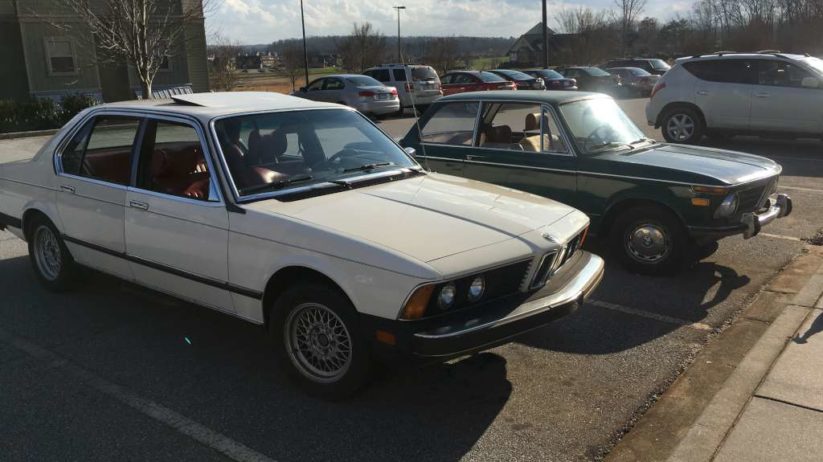In last week’s article, I described driving Louie the 2002tii another 60 miles past the BMW CCA Foundation in order to go look at another car, my logic being that after I dropped off Louie, I’d need to get back home to Boston somehow, and could either purchase a one-way ticket and fly, or drive home in something interesting (plus, with Louie gone, I’d have an open space in the garage). I’d pounded on Craigslist in the Greenville area for a month before the trip, hoping to dislodge something compelling.
Last week I was coy and didn’t want to reveal what the car was, as I was hoping things might play out to my advantage. Now I can tell the tale.
The car was a 1979 733i, a model that figures in my origin story. As I wrote last December when I looked at another 733i, a Hampshire college student lived with us for a summer when I was thirteen. He had a ’71 2002 in which he used to drive me around the backroads of Amherst, Massachusetts. That’s what imprinted me on 2002s.
But about eight years later, the same guy called me out of the blue and said that he’d started a computer company in Cambridge—and offered me a job. Initially, I was a gofer, and my main responsibility consisted of errand-running in his new BMW, a ’78 E12 530i.
When I graduated college, I began working for him full-time. By then, he’d traded the 530i for an E23 733i, whose feeling of solidness and stability at speed were absolutely astonishing.
The mid-1970s through early 1980s were a tough time for all auto manufacturers; the twin events of the DOT 5-mph bumper mandate in 1974 and the EPA putting the screws to emissions controls in 1975 were difficult to deal with. Manufacturers produced cars with slapped-on diving-board bumpers and hastily-added performance-robbing emissions-control systems. While most cars received catalytic converters, the big six-cylinder BMWs (and the 1975 2002) got thermal reactors, an oxygen-injecting-and-burning device integrated directly into the exhaust manifold, which ran so hot you could see it glowing red at night. This resulted in cracked heads, making the reactor-equipped 530i, 633i, and 733i among the least-desirable BMWs ever built; it alienated a generation of BMW owners, and put the reputation that BMW was developing as a sporting alternative to Mercedes at risk.
But it’s a little unfair to single out BMW. I think you’ll find that for most makes, the cars that are desirable are pre-’74 (small bumpers and minimal smog controls), and then post-1982-ish, when the—ahem—smoke settled and emissions controls were designed in, rather than slapped on. In between, well, you have to love them and choose carefully. Look at Porsche: 1975 through 1977 911s are the least desirable of all due to hot-running engines needed to mitigate emissions. In ’78 through ’82 they went to the 911SC that had K-Jetronic injection, oxygen sensors, and cats; then, in ’83, they went to the Motronic-equipped Carreras.
But I digress. In the BMW world, the big cars went from L-Jetronic injection and thermal reactors in the mid-to-late-’70s to L-Jetronic with Lambda (oxygen sensor) and catalytic converters in about 1980, and to Motronic (O2 sensor, cats, and full digital engine management of both fuel mixture and spark advance) in about 1982. In addition, the mid-life model freshening that included the switch from reactor to cat also included a transmission update from four-speed to five-speed. This is why the E12 528i (cat, O2 sensor, and five-speed) is more desirable than the earlier 530i (reactors and four-speed). The same holds true for E23 7 Series cars: The early ones had thermal reactors and an available four-speed, and the ’81 and ’82 cars had an O2 sensor, cats, and an available five-speed.
Then, in 1983, the car was facelifted and outfitted with a Motronic-equipped engine. The rub is that as time progressed, fewer 733is were outfitted with standard transmissions.
While I can’t say that I have pined for or actively lusted after an E23 in the same way as I have its more svelte and comely sisters, there is a cleanness and a purposefulness to Paul Bracq’s design for the E23. It has the same shark nose as the early 6 Series cars, and similar details in the way the trim wraps around the back windows. And the big U.S.-spec bumpers don’t bother me on the E23 the same way they do on the 635CSi; it’s not like they’re destroying a shape that without them would be trim and sculpted.
And since demand is low, E23 7 Series cars are pretty cheap—if you can find a rust-free, reactor-free example with a stick. I’ve had my eyes peeled for a while, particularly for something with Polaris paint and a red leather interior. Last December, I wrote about looking at an appealing-sounding Chestnut Brown ’81 733i five-speed in Maine on which I passed due to rust.

With all this as context, then, you can understand why a 1979 733i with 95,000 miles on it—white with a red leather interior and standard transmission—advertised for $3,500 on Craigslist in Greenville (not far from the BMW CCA Foundation in Greer) caught my eye. The car looked great in the photos; it had no obvious exterior issues, and just some wear creases on the red leather of the driver’s seat. In the ad, the car was wearing fifteen-inch basketweaves, but it also had its original fourteen-inch finned Alpina-style alloys. And when I looked closely at the engine-compartment pics, I could see a set of exhaust headers where the thermal reactors used to be—a big plus.
Also, the ad said that the car was a five-speed, not a four-speed, which was curious.
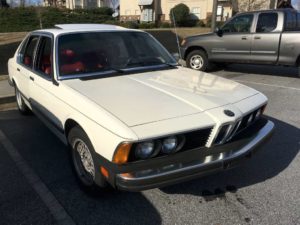
I spoke with the seller, a mechanical-engineering student at a nearby college. He’d bought the car a few years ago because he wanted something cool, and sorted out some—but not all—of its issues. He said that the car was rust-free, and that its main issues were that the exhaust was loud and somewhat boogered together; the heat was stuck on the defrost setting; the a/c didn’t work; and the driver’s-side door had to be unlatched from the inside.
When I asked for the VIN and ran it through a VIN decoder, I learned that the car was a converted automatic. On a closer look at the CL photos, I could see that the automatic’s PRND21 indicator was still present at the top of the instrument cluster. The seller said that he’d bought something more reasonable and less time-consuming, but stressed that he didn’t really need to sell the E23.
I asked him how loud the exhaust was. “It’s pretty loud,” he said, “especially when you get on it.”
I remembered the experience of driving Louie home after I bought him, where the first twenty miles were quiet, but after that a bunch of rust pinholes on one of the exhaust flanges yawned open and merged together, and it was really loud and snotty whenever I goosed it. Finally I asked, “This isn’t a trick question, and no lawyers will visit your home, but would you drive it to Boston?”
“Yeah, actually, I would,” he said. I told him that I was interested, explained the parameters of my trip down to Greer with Louie, and said that I’d keep him apprised of my plans.
Because of my shifting schedule, what followed was by far the longest series of text messages ever required to see a car. In the meantime, I kept checking the ad. The seller kept changing the price, varying it as low as $3,200 and as high as $4,000. But when I finally left Boston for the Foundation, I arranged to see the car the afternoon that I planned to arrive in Greer. The seller said he had a class at 6:00 p.m., and after that would not be available until about 4:00 p.m. the following afternoon. So it seemed that if my goal was to see the car, make a judgement as to whether I was going to buy it, do the transaction, transfer the tools and parts from Louie’s trunk into the E23’s instead of shipping them home, and be on the road, I had a short window.
I was delighted to find, when I scouted the nearest branch office of my bank, that there was one only seven miles away, so I didn’t even need to pre-emptively bring cash; I could run to the bank if purchasing the car made sense. And I made sure to bring the plate from my 635CSi to slap on it, as that, a bill of sale, and a call to Hagerty should be enough to cover me unless I was stopped and an officer of the law decided to be particularly zealous.
Unfortunately, when I was a day away and I mapped the seller’s exact address, I found that he wasn’t as close to the Foundation as I’d inferred from the CL ad (which showed up as Greenville as opposed to “nearby areas”); he was 60 miles further southwest. Suddenly this wasn’t a “while you’re in the neighborhood” thing; it was another 120 miles and two hours of driving at the end of a very long day. It had my head spinning over the logistics of dropping off Louie and picking up this car—Uber? Favor from someone at the Foundation?—and I wondered if I should just blow it off entirely.
Still, if I’ve learned anything about buying cars, it’s that you need to go and look. Forest Gump’s mother may have said, “You never know what you’re going to get,” but the automotive corollary is, “You never know what you’re passing on.”
I did a little research about the heat that the seller said was stuck on the defrost setting, and learned about the E23’s complex vacuum-actuated HVAC system; apparently, either by design or by happenstance, when the system fails, it reverts to the default setting of heat through the defroster vents. It appears to be a fairly common problem, which is not to say that it’s easy; owners describe removing the dashboard to track down the fault. Since, if I bought the car, I’d be driving it home in February, I initially wondered whether my hands and feet would be adequately warm. However, my drive down was in unseasonably warm weather, and I instead began wondering how easy it would be to bypass the heater core by connecting the hoses together, as I did last year with Louie when his heater core was leaking.
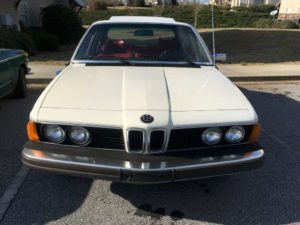
When I arrived, tired and sweaty, I found the seller changing the 733i’s oil in the parking lot of an apartment complex. My first impressions of the car were surprisingly good; a walk-around indicated that portions of the car had been repainted, but not glaringly so. The only dent was a very small section behind the left rear wheel where a bad blowout had caused the tread to separate and smack the body. The car was wearing odd black hood and trunk roundels, but this was just a curiosity.
The red leather interior was beautiful, and popped against the white paint in a way that wasn’t shown in the photos. It also had two very cool interior period pieces: an old-school cell phone and a BMW-branded CB radio.
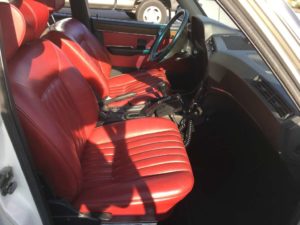
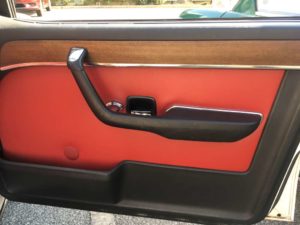
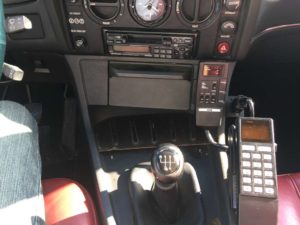
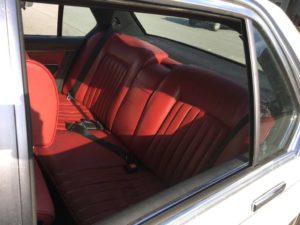
I then did a skooch-around and a crawl-under. Incredibly, they revealed no rust other than isolated spots of minor surface oxidation. However, they also showed that the exhaust was hanging so low that it nearly looked like side pipes.
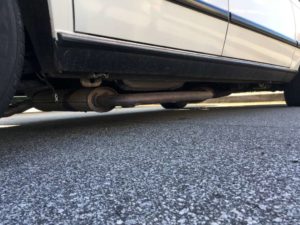
And the rear section of the exhaust was missing. Where there should be a rear muffler, there was instead a corrugated pipe that stretched nearly out from under the back bumper. While I admired the young man’s Hack tendencies, it was, well, unexpected.
I got into the car. The red leather driver’s seat enveloped me in an unexpected and delightful way. Damn, I thought, I might actually enjoy driving this luxotank home.
Then I turned the key.
Now, when someone says a car has a loud exhaust, you might think you know what that means, and in my case, I’d equated it to driving Louie home last year. But the 733i’s M30B32 engine is considerably larger than the 2002’s four-pot. This thing was deafening, like NASCAR loud, even at idle. And when I revved it, it just blared.
I balked. “Do you drive it like this?” I asked.
“Well,” the seller said, “at the moment, it’s not registered. I transferred the plates on my other car.”
I got out and examined the exhaust more closely, starting in the engine compartment. The short headers, which replaced the execrable thermal reactors, were plainly cracked.

Suddenly, the headers, which had been a positive, were a detriment. I crawled back under the car. I couldn’t get my hands around each component to feel where the leaks were coming from, but I saw that among the reasons the exhaust was so low was that it wasn’t held on by the stock clamps and rubber hangers, and instead was hanging from steel cables and carabiner-style threaded connecting links. I realized that in addition to being blaringly loud, one good pothole and the whole thing would likely be dragging on the asphalt.
Still, I was curious enough that we carefully took the car for a short drive, heading out of the apartment complex and onto the road and driving about a quarter mile. However, driving a car that is both deafening and illegal makes it difficult to judge much of anything. When you drive, you’re naturally attuned to whether a car is smooth at steady throttle and under acceleration or whether it stumbles, but when an exhaust is basically nonexistent, it makes it hard to judge these things, as instead all you sense is LOUD. Plus, if I was actually going to entertain driving this thing a thousand miles north to Boston, I’d want to at least take it up on the highway a few exits and make sure that the temperature gauge sits in the middle and that the car tracks straight. With the car both illegal and tinnitus-inducing, I couldn’t do that—or at least I didn’t want to.
More to the point, the idea that I could drive the car home as-is suddenly seemed ludicrous. From a noise, safety, and legality standpoint, I might chance driving it the 60 miles back to Greer, but not the thousand miles back to Boston. I know, I know; it sounds like I’m getting soft. Maybe I am. But this wasn’t just a little loud some of the time; it was really loud all the time¸ and DEAFENINGLY loud when you got on it. I considered the chance of being stopped by law enforcement quite high.
I tried to take it all in, as this was my window right here: Make a deal or go back to my hotel and buy a plane ticket for the next day.
I weighed the choice. About $300 for the ticket, $25 for the baggage fee, about $90 to ship home the boxes of tools and parts in Louie’s trunk… that’s over $400 I could spend on an exhaust. I began thinking. Could I “do a Louie?” Could I buy the car and then camp out somewhere—a hotel or a BMW CCA member’s house—while I quieted down the exhaust enough to drive the car home?
And what would that entail?
Either the cracked headers needed to come off and be welded, or other M30 exhaust manifolds would need to be used. For the rest of the exhaust, it was likely that the entire boogered-up mess would need to come off and something new procured and installed—and it was difficult to imagine that I could click on and buy inexpensive exhaust sections for a 1979 733i and have them arrive in a timely manner. The only real time-efficient play would be to take the car to an exhaust shop and have it fitted with a custom exhaust. Considering that the headers needed to be welded, I guestimated the cost for this might be in the $500-to-$1,000 range. To try to do anything else inexpensively—say, comb eBay for aftermarket exhaust pieces—requires time and space, neither of which I had down in South Carolina. Plus, I had a singer-songwriter gig in four days. It’d take a lot more than a 733i with red leather for me to miss it.
I couldn’t see how I could drive the car home, but I tried to separate that from the issue of the car’s value. I asked the seller the question I rely on so often: “What do you need to get for it?”
“Well,” he said, “I paid $2,800 for the car. I have quite a bit more into it than that, but my best price right now would be $2,800.”
As I’ve said repeatedly, the reason Maire Anne stays married to me is that most of the time, I am unflinchingly rational about these sorts of purchases. I can’t buy needy cars on a whim if I can already see that I’ll lose money if I need to sell them; E23s simply aren’t worth much. The low mileage, rust-free body, and pretty white paint against the red leather interior made the car appealing to me, and with the five-speed, they may have made the car worth about what the seller was asking—if it didn’t need any obvious work. But factoring in that the car was essentially unusable until it got an exhaust, that the HVAC fix required an unknown amount of work, that if I sold it, some folks might be put off by the incomplete automatic-to-stick conversion (the PRNDL21 indicator in the cluster), and that there was some cost associated with getting it home, I’d have to pick the car up pretty cheaply for it to be worth my while.
How cheaply? I needed to think about that, but certainly much less than $2,800.
So, while the car did indeed tug at me, and while I hated to leave it, I thanked the seller and did just that. Louie and I drove off. I checked into my hotel, and was online buying a one-way ticket home when I got a text message from the seller: “What do you think I’d need to do to sell it?”
Ah, I thought, this is how my Hack Jedi skills are brought to bear, even when I’m not trying to use them. I explained about the double-edged sword of the loud exhaust and the lack of registration, and advised that quieting down the car would be the best thing he could do to help move it.
Out of curiosity, I re-checked the Craigslist ad. The price hadn’t changed, but one of the photos now showed Louie next to his car. I texted that I’d need to charge him for that kind of publicity.

Then the seller texted me again and asked me if I would be interested in the car if he fixed the exhaust and drove it up to Boston, saying he had relatives in the area and might be up in the spring. I gave him a measured answer: Maybe, but there’s a lot of time between now and then, I might buy something else, it would depend on the price and how the repair was done, etc. The next day I flew home, and that was that.
Yeah, right.
I knew that there was unfinished business, because I kept thinking about the car. I looked up part numbers for the exhaust. I found some new-old-stock original and aftermarket pieces on eBay and BavAuto, but it was unclear whether they’d mate with each other. I looked but couldn’t find the original manufacturer of the short headers which attached to the tops of the original downpipes. I forwarded all of this information to the seller, explaining that this is how I work, sharing information. I heard nothing back.
A few days later, some numbers finally popped into my head: If the car was in Boston, I’d probably wind up buying it, after negotiation, for two grand. Some folks might not think it was worth that, but I liked it. But considering that it was near Greenville and I was now home, there would be shipping costs associated with getting it back. UShip estimated the shipping costs at $500, which seemed low, but hey, data is data (the former researcher in me would say “data are data,” but that would be geeky), so for remote purchase, an offer would be $1,500. I wrote all this up and sent it to the seller, and still heard nothing back.
Then the ad vanished from Craigslist—but it was listed as expired, not deleted.
A few days later, the seller contacted me, thanked me for the information, and said that his father was experiencing some health issues, so the sale of the car was back-burnered. So we’ll see. I made my offer. It was received. I’m not going to push.
I harbor a sneaking hope that I’ll wind up with the car in a timeframe that would let me scope out some repair and sleeping space in Greer for a few days, procure an exhaust and get it shipped down, fly in, fix the car, and then drive it directly from there to the Vintage in Asheville, and then home. I mean, I’ve done stupider things.
And my butt would look great in red leather.—Rob Siegel
Got a question for Rob Siegel, the Hack Mechanic? You can find him in the BMW CCA Forums here!
Rob’s new book, Ran When Parked: How I Resurrected a Decade-Dead 1972 BMW 2002tii and Road-Tripped it a Thousand Miles Back Home, and How You Can, Too, is now available on Amazon. Or you can order personally inscribed copies through Rob’s website: www.robsiegel.com. His new book, Just Needs a Recharge: The Hack MechanicTM Guide to Vintage Air Conditioning, will be out in the spring.

